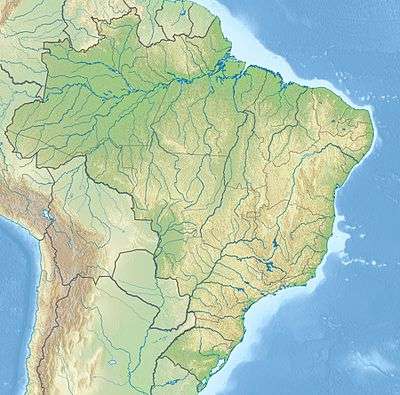Tupinambás Ecological Station
| Tupinambás Ecological Station | |
|---|---|
| Estação Ecológica Tupinambás | |
|
IUCN category Ia (strict nature reserve) | |
 Location in Brazil | |
| Nearest city | Guarujá, São Paulo |
| Coordinates | 24°05′S 45°44′W / 24.08°S 45.73°WCoordinates: 24°05′S 45°44′W / 24.08°S 45.73°W |
| Area | 2,464 hectares (6,090 acres) |
| Designation | Ecological station |
| Created | 20 July 1987 |
Tupinambás Ecological Station (Portuguese: Estação Ecológica Tupinambás) is a marine ecological station in and around the Alcatrazes archipelago off the coast in São Paulo State, Brazil.
History
The Tupinambás Ecological Station is a Federal conservation area covering 2,464 hectares (6,090 acres) administered by the Chico Mendes Institute for Biodiversity Conservation. It was created on 20 July 1987.[1] It consists of the Paredão island between about 24°04' and 24°05' S and 45°43' and 45°44' W, the islets of Abatipossanga, Guaratingaçu, Carimacuí and Cunhambebe between about 24°06' and 24°07' S and 45°42' and 45°43' W, and other islets and rocks, and the sea within a radius of 1 kilometre (0.62 mi) from their surf. It is in the São Sebastião and Ubatuba municipalities of São Paulo State.[2]
Status
As of 2009 the Ecological Station was a "strict nature reserve" under IUCN protected area category Ia.[3] Migratory species include royal tern (Sterna maxima), spotted sandpiper (Actitis macularia), South American tern (Sterna hirundinacea), white-rumped sandpiper (Calidris fuscicollis), Cape petrel (Daption capense), wandering albatross (Diomedea exulans), Wilson's storm petrel (Oceanites oceanicus), Magellanic penguin (Spheniscus magellanicus), orange-breasted falcon (Falco deiroleucus), ultramarine grosbeak (Passerina brissonii), peregrine falcon (Falco peregrinus), great shearwater (Puffinus gravis), black-browed albatross (Thalassarche melanophris), humpback whale (Megaptera novaeangliae), Bryde's whale (Balaenoptera brydei),[4] common minke whale (Balaenoptera acutorostrata), Atlantic yellow-nosed albatross (Thalassarche chlororhynchos) and giant oceanic manta ray (Manta birostris).[2]
Endemic critically endangered land species include the pit viper Bothrops alcatraz and the frogs Cycloramphus faustoi and Scinax alcatraz.[2]
References
- ↑ Esec Tupinambás – Chico Mendes.
- 1 2 3 Unidade de Conservação ... MMA.
- ↑ Triana 2009.
- ↑ Bragança D.. 2017. Projeto monitora baleias no litoral norte de São Paulo. GoEco - Volunteer Abroad for Ecological & Humanitarian Projects. Retrieved on October 03, 2017
Sources
- Esec Tupinambás (in Portuguese), Chico Mendes Institute for Biodiversity Conservation, retrieved 2016-04-18
- Triana, Elisa (29 May 2009), "Strict Nature Reserves in Brazil", The Encyclopedia of Earth, retrieved 2016-04-15
- Unidade de Conservação: Estação Ecológica Tupinambás (in Portuguese), MMA: Ministério do Meio Ambiente, retrieved 2016-04-18